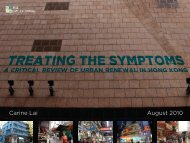Untitled - Civic Exchange
Untitled - Civic Exchange
Untitled - Civic Exchange
Create successful ePaper yourself
Turn your PDF publications into a flip-book with our unique Google optimized e-Paper software.
Chapter 3:<br />
Road versus Rail - Financing Mass Transit in Hong Kong<br />
consultants are allowed to publish tends to be skewed in such a way as to largely pre-determine the<br />
conclusions. The results are then put out by the Transport Department as definitive, when in fact, important<br />
factors or alternatives have not even been considered.<br />
Although there are plans for a major expansion of the HKSAR's passenger rail system, it is<br />
noteworthy that the Transport Bureau proposes to do this without changing the manner in which<br />
railways in Hong Kong are financed. Continuation of current transport financing policy seems likely,<br />
despite the fact that the rail self-financing policy causes high external costs (less mobility, more pollution<br />
and noise) for everyone in Hong Kong.<br />
Passenger journeys<br />
The adverse effects of the requirement that rail systems be largely self-financing are demonstrated by the<br />
absence of rail in a number of Hong Kong's major population centers. Urban areas housing hundreds of<br />
thousands of people and lying only a few kilometers from an existing rail line may remain unconnected to<br />
rail for many years. For example, in what other "world city" would communities like Ap Lei Chau/Wah Fu<br />
or Ma Tau Wai remain without rail service, despite serious congestion and air pollution It seems unlikely<br />
that this situation would occur in the service areas of other urban systems covered in the rail study.<br />
Due to differences in government support for different transport modes, more travelers use road transport<br />
than would otherwise be the case. Overall, somewhat more than two journeys on road occur for each<br />
journey by rail. This reliance on road transport is not good from the standpoint of mobility or the<br />
environment. The fact that one-third of all journeys occur by rail may appear impressive, but Hong Kong's<br />
high density and income levels make the potential for rail-based transit here the highest in the world. Yet<br />
among the 15 systems surveyed, Hong Kong barely made the upper third of those surveyed with respect to<br />
the role of rail transport relative to road transport. Logically, we should be number one.<br />
Our point here is not that buses should lose their cross-subsidy but that current government policies do<br />
provide financial support for some transport modes, with the result that the overall external costs to the<br />
Hong Kong community are higher than they would be otherwise. Buses provide essential external benefits<br />
compared to other forms of road-based transport, such as taxis and private vehicles, and have a crucial role<br />
to play in a more sustainable transport system for Hong Kong. Nonetheless, buses are more energyintensive<br />
and polluting than rail and should play a complementary role to rail transport. Moreover,<br />
government claims that current transport policies reflect a laissez faire and impartial financing system are<br />
simply untrue. Current policies do provide de facto subsides for certain modes of transport.<br />
The way in which particular transport modes are financed has a profound effect on the quality of life for<br />
everyone. This occurs directly through the level of fares and accessibility to transport and indirectly<br />
through the external impacts of modal choice. And in dense urban areas, the external effects of modal<br />
choice intrude on our lives around the clock. We urge that the same logic that is applied in providing<br />
indirect financial support for bus transport should be applied to rail - i.e., support in covering the costs of<br />
basic infrastructure provision. This should be accompanied by a concerted effort to promote substantial<br />
bus-rail coordination.<br />
The survey of urban rail systems mentioned here suggests alternative models for financing rail transport. For<br />
example, what would be the external economic, mobility, and environmental benefits for Hong Kong if:<br />
• The government followed the model applied in other cities around the world and funded -<br />
through direct grants - a substantial portion (e.g., 60%-70%) of the cost of new passenger<br />
railway construction<br />
27

















